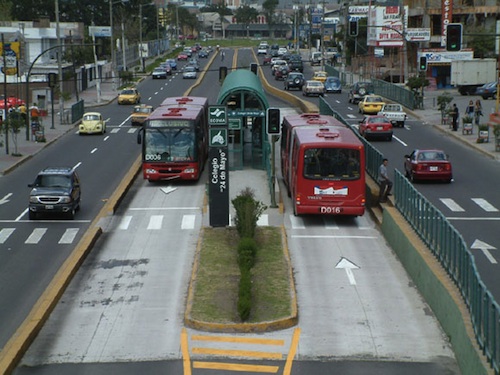Let’s start with an understanding of what “Bus Rapid Transit,” or BRT, is. This article gives a good summary; essentially, it’s like giving a bus its own lane and having stations at each stop. Overall, it’s like turning bus travel into light rail travel, but at a fraction of the cost (for the city to build and the riders to ride). Here’s a little more on how they work; they’re pretty popular globally (especially in South America, detailed in that top video), but they haven’t caught on massively in the U.S. yet. You could claim 33 U.S. cities have a BRT system, but in most of those cities it’s limited to one line, or one area of town — i.e. it’s not very far-reaching. The Emerald Express concept, in Eugene (OR), is considered one of the best in America.
Obviously this conversation is deeply tied up in how America looks at its cities — we tend to view cars as essential, even if they’re not — and how cities plan for human traffic and auto traffic, and of course (as always) the rise of the suburbs. So there are issues currently in play that make BRT impossible, or nearly impossible, in some communities. But more cities do need to embrace it, and here’s why:
Taking street space from cars and giving it to buses will change the commuting habits of the people who currently drive there. It will slow down cars a bit and it will encourage people to drive on other streets. It will also likely make auto-oriented retail stores (i.e. those with lots of parking) less appealing. But making room for BRT will also do something else: it will make taking the bus a lot more convenient and increase the number of people walking down the street to get to stations.
In research we conducted at the Metropolitan Planning Council, we found that a new, $160 million BRT line on Chicago’s Ashland Avenue — a route that already serves more than 30,000 daily riders — would dramatically improve the effectiveness of the city’s transit system. For people living near several stations, the number of jobs accessible within a 20-minute transit commute would increase by more than 80 percent. The line itself would increase the number of people living and working within a quarter mile of a rapid transit station by 80,000 and 25,000, respectively — hardly a drop in the bucket.
People don’t often casually think of this, but if you fix some things around buses, suddenly the trickle-down has to do with jobs, and getting to jobs. In sum, public transportation is essentially important for a modern U.S. city.
Now check this out. Since 2001, 10 U.S. cities with rail (train) systems haven’t seen those systems expanded. In nine of those cities, train ridership has still dwarfed bus ridership. The outlier? Buffalo, NY.
Buffalo is, in some ways, the perfect example of an American city that needs BRT. It’s growing in general, it has a cluster of medical/university buildings with jobs that people need to get to, and … well, the rail service is failing people:
The significant drop in rail ridership occurs at an inopportune time for the NFTA, as the surge in new jobs at the downtown Buffalo Niagara Medical Campus offers a chance for the subway to ferry many more commuters back and forth to work each day.
With new housing construction planned near subway stations for Medical Campus workers using Metro Rail, and with parking limited on the campus, the system is predicted to assume a vital transportation role in the city’s future. In fact, ridership was rising before the Main Street project began.
Morgado fits the profile of the new Metro Rail commuter.
An information technology specialist at Roswell Park Cancer Institute, the Clarence resident has been buying monthly passes that the Medical Campus promoted. He says he would rather park in the LaSalle lot than drive downtown, because the subway is “more direct.”
“But the 20-minute trains are killing me,” he said.
Stuff like this — putting a BRT system in place in a blue-collar urban area that is seeing some job growth in health and medical — is how you can transform the notion of a city, which is akin to what’s happening in Pittsburgh right now too. Again, BRT isn’t simple — it requires infrastructure and a different approach to how cars share roads and where cars might end up if they lose one lane. There are decisions to be made, sure. But for a place like Buffalo and many like it, it could be an essential way to connect people to jobs and opportunities without the capital expenditures and hassles of a light rail line.


Why don’t you and my boyfriend just get married already
Better late than never: So the thing about BRT is we don’t know what kind of land use changes it can generate, whereas it’s pretty clear that rail of any type has seriously positive land value impacts near station areas. (except main street buffalo, i guess). . I do agree that BRT a better investment for smaller cities, but the issue from the real estate perspective is always about operating money. There’s a fear that the BRT stations will lose more service than rail stations in case of budget cuts, which is usually what happens now.
Exactly.
Nice weblog here! Also your site rather a lot
up very fast! What web host are you using? Can I get your affiliate hyperlink on your host?
I wish my website loaded up as fast as yours lol
WordPress, baby! Ground and pound!